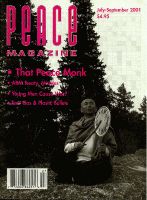
Peace Magazine Jul-Sep 2001, page 12. Some rights reserved.
Search for other articles by Maggie McDonald here
With searing eyes and rasping lungs, thousands braved the clouds expelled by four thousand canisters of tear gas in Quebec City. But the effects braved by protesters at the April Summit of the Americas may be more than temporary. Besides respiratory problems, people experienced other disquieting symptoms. After the summit rumors circulated about rashes, nausea, dizziness, tingling in the extremities and menstrual disruptions. While the demand for a public inquiry into police tactics is growing, evidence also points to the need for a scientific inquiry into the long-term effects of tear gas.
Menstrual anomalies like early periods, heavy cramping, late periods, and even a miscarriage were reported to volunteer medics in the wake of the Seattle gassings at the World Trade Organization protests in November of 1999. I sent an email out to a Toronto area activist listserv, asking if any women who'd been at the summit had similar experiences. The emails soon poured in. The majority of respondents experienced early menstruation, though emotional stress usually causes a delayed period.
The tear gas used in Seattle contained a chemical called methylene chloride, an organochlorine. The exact chemical contents of the gases used in Quebec are not yet known. But, given the symptoms protesters experienced, we can suspect the presence of "Endocrine Disrupters."
Endocrine Disrupters (EDs) like dioxin, organochlorines, PCBs, and furans have been suspected of ill-doing for decades. In the technical text Generations at Risk, endocrine disrupters are defined as "chemicals that mimic or block hormones or otherwise interfere with normal hormone activity, often at extremely small doses." Laboratory animal studies of these chemicals have shown mutations that correlate to mutations seen in birds and fish from polluted areas. Fearing similar effects in humans, Theo Colburn, Dianne Dumanoski, and John Myers wrote the book Our Stolen Future, which was first published in 1996. In his introduction to the book, Al Gore declared, "Last year I was asked to write a foreword to the thirtieth anniversary edition of Rachel Carsons's classic work, Silent Spring. Little did I realize that I would so soon be writing a foreword to a book that is in many respects its sequel."
Whereas Carson's book focused on the effects of man-made pesticides, Our Stolen Future details the effects of a the more subtle invasion of EDs. Currently, less evidence exists to support the Stolen Future thesis than did for Carsons's book at the time of its publication. Still, the evidence provided is compelling.
Endocrine DisruptersGregg Easterbrook and scientists such as Stephen Safe decried the Endocrine Disrupter controversy as a false alarm. Easterbrook called the book "science fiction" in The New Republic magazine. However, additional research will likely point fingers at corporate polluters and result in legislation that limits profitability of many industries.
When treated primarily as a threat to sperm counts, the evidence supporting an ED panic is weak. But when women's health problems like endometriosis and breast cancer are considered, evidence points to endocrine disrupters as a cause. If women's health problems were considered in such arguments more often, cures to these illnesses might be found.
Most critiques of Our Stolen Future rely on aggregate statistics to confirm or deny the presence of ED-related health problems. This ignores the reality that diseases influenced by pollutants will be distributed unevenly across racial and economic boundaries. Women of color facing discrimination and poor women will be more likely to live in polluted areas or be forced to work with hazardous chemicals. Also, the health concerns of these women will be treated differently. Endometriosis symptoms (chronic period-related pain) may be dismissed as a psychological condition and ignored.
The abnormal menstrual effects after Quebec call for research into the long term effects of tear gas. The debate over EDs needs to be revived. Many groups are discussing the possibility of a lawsuit. This action should be linked to the larger issue of organochlorines, dioxins and furans in our air, water and bodies. A crowd control device containing Endocrine Disrupters is not just a weapon against a crowd; it is a weapon against the future.
Selected SourcesTheo Colborn, Dianne Dumanoski, and John Peterson Myers, Our Stolen Future: Are We Threatening Our Fertility, Intelligence, and Survival?- A Scientific Detective Story. Toronto: Penguin Books, 1996.
Easterbrook, Gregg. "Another Phony Health Scare," The New Republic, Aug. 30th, 1999.
Safe, Stephen. "Environmental Health and Dietary Estrogens and Human Health: Is There A Problem?" Environmental Health Perspectives, Vol. 103, No. 4, April 1995. pp. 346-351
Ted Schettler, Gina Solomon, Maria Valenti, and Annette Huddle, Generations at Risk: Reproductive Health and The Environment. Cambridge: MIT Press, 1999. Maggie MacDonald is a member of Science for Peace studying at U. of Toronto.

Peace Magazine Jul-Sep 2001, page 12. Some rights reserved.
Search for other articles by Maggie McDonald here